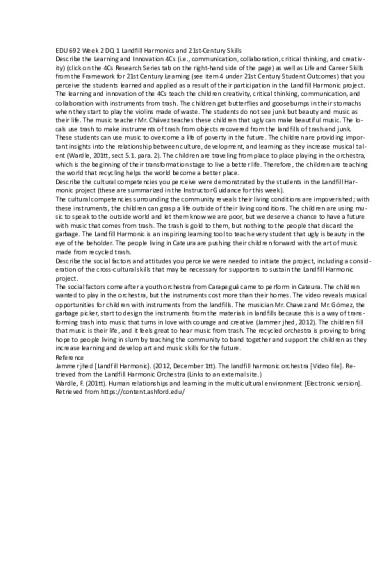EDU 692 Week 2 DQ 1 Landfill Harmonics and 21st PDF

| Title | EDU 692 Week 2 DQ 1 Landfill Harmonics and 21st |
|---|---|
| Author | kimi raik |
| Course | Creativity, Culture, & Global Contexts in Education Decision Making |
| Institution | The University of Arizona Global Campus |
| Pages | 1 |
| File Size | 36.3 KB |
| File Type | |
| Total Downloads | 106 |
| Total Views | 131 |
Summary
Study notes and Coursework...
Description
EDU 692 Week 2 DQ 1 Landfill Harmonics and 21st-Century Skills Describe the Learning and Innovation 4Cs (i.e., communication, collaboration, critical thinking, and creativity) (click on the 4Cs Research Series tab on the right-hand side of the page) as well as Life and Career Skills from the Framework for 21st Century Learning (see item 4 under 21st Century Student Outcomes) that you perceive the students learned and applied as a result of their participation in the Landfill Harmonic project. The learning and innovation of the 4Cs teach the children creativity, critical thinking, communication, and collaboration with instruments from trash. The children get butterflies and goosebumps in their stomachs when they start to play the violins made of waste. The students do not see junk but beauty and music as their life. The music teacher Mr. Chávez teaches these children that ugly can make beautiful music. The locals use trash to make instruments of trash from objects recovered from the landfills of trash and junk. These students can use music to overcome a life of poverty in the future. The children are providing important insights into the relationship between culture, development, and learning as they increase musical talent (Wardle, 2013, sect 5.1. para. 2). The children are traveling from place to place playing in the orchestra, which is the beginning of their transformation stage to live a better life. Therefore, the children are teaching the world that recycling helps the world become a better place. Describe the cultural competencies you perceive were demonstrated by the students in the Landfill Harmonic project (these are summarized in the Instructor Guidance for this week). The cultural competencies surrounding the community reveals their living conditions are impoverished; with these instruments, the children can grasp a life outside of their living conditions. The children are using music to speak to the outside world and let them know we are poor, but we deserve a chance to have a future with music that comes from trash. The trash is gold to them, but nothing to the people that discard the garbage. The Landfill Harmonic is an inspiring learning tool to teach every student that ugly is beauty in the eye of the beholder. The people living in Cateura are pushing their children forward with the art of music made from recycled trash. Describe the social factors and attitudes you perceive were needed to initiate the project, including a consideration of the cross-cultural skills that may be necessary for supporters to sustain the Landfill Harmonic project. The social factors come after a youth orchestra from Carapeguá came to perform in Cateura. The children wanted to play in the orchestra, but the instruments cost more than their homes. The video reveals musical opportunities for children with instruments from the landfills. The musician Mr. Chavez and Mr. Gómez, the garbage picker, start to design the instruments from the materials in landfills because this is a way of transforming trash into music that turns in love with courage and creative (Jammer jhed, 2012). The children fill that music is their life, and it feels great to hear music from trash. The recycled orchestra is proving to bring hope to people living in slum by teaching the community to band together and support the children as they increase learning and develop art and music skills for the future. Reference Jammer jhed [Landfill Harmonic}. (2012, December 13). The landfill harmonic orchestra [Video file]. Retrieved from the Landfill Harmonic Orchestra (Links to an external site.) Wardle, F. (2013). Human relationships and learning in the multicultural environment [Electronic version]. Retrieved from https://content.ashford.edu/...
Similar Free PDFs

Week 2 DQ 1 - answer to DQ
- 1 Pages

Week 3 DQ 2 - answer to DQ
- 1 Pages

Week 2 DQ 2 - graded
- 1 Pages

Week 3 dq 2 - graded
- 2 Pages

Week 6 DQ 1&2 - Discussion
- 5 Pages

DQ 1 Week 5 - Discussion
- 1 Pages

Topic 2 DQ 1
- 1 Pages

Topic 2 DQ 1
- 2 Pages

Week 2 DQ 2 2919 - Week2DQ2
- 1 Pages

Topic 7 DQ 1 and Topic 7 DQ 2
- 2 Pages

Topic 2 DQ 1-2
- 1 Pages

Topic 2 DQ 1 and 2
- 2 Pages

P0sts - DQ week 4
- 4 Pages

Topic 5 DQ 2 - DQ 2
- 1 Pages
Popular Institutions
- Tinajero National High School - Annex
- Politeknik Caltex Riau
- Yokohama City University
- SGT University
- University of Al-Qadisiyah
- Divine Word College of Vigan
- Techniek College Rotterdam
- Universidade de Santiago
- Universiti Teknologi MARA Cawangan Johor Kampus Pasir Gudang
- Poltekkes Kemenkes Yogyakarta
- Baguio City National High School
- Colegio san marcos
- preparatoria uno
- Centro de Bachillerato Tecnológico Industrial y de Servicios No. 107
- Dalian Maritime University
- Quang Trung Secondary School
- Colegio Tecnológico en Informática
- Corporación Regional de Educación Superior
- Grupo CEDVA
- Dar Al Uloom University
- Centro de Estudios Preuniversitarios de la Universidad Nacional de Ingeniería
- 上智大学
- Aakash International School, Nuna Majara
- San Felipe Neri Catholic School
- Kang Chiao International School - New Taipei City
- Misamis Occidental National High School
- Institución Educativa Escuela Normal Juan Ladrilleros
- Kolehiyo ng Pantukan
- Batanes State College
- Instituto Continental
- Sekolah Menengah Kejuruan Kesehatan Kaltara (Tarakan)
- Colegio de La Inmaculada Concepcion - Cebu

